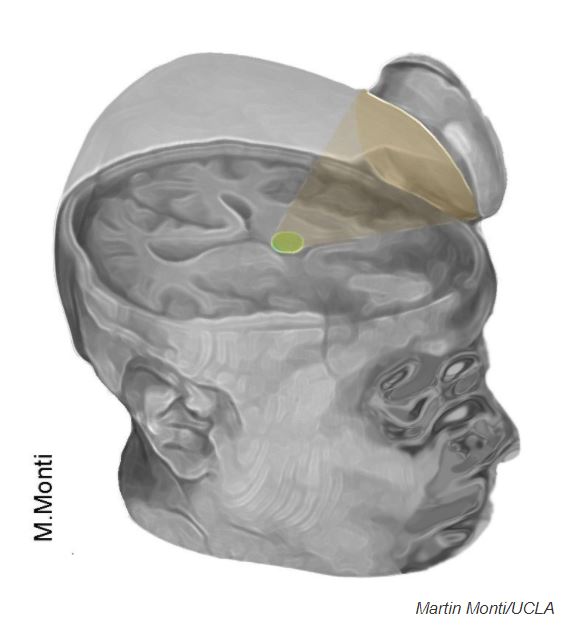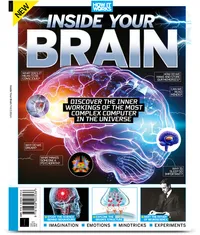Ultrasound treatment 'jump-started' the brains of 2 people in coma-like state
Two patients were minimally conscious for years. Then, an experimental ultrasound treatment 'jump-started' their brains.

An experimental treatment may have "jump-started" the brains of two patients who had been in a minimally conscious state for months following a coma, according to a new study.
Both patients had severe brain injuries and had shown only limited signs of consciousness for more than a year. But after receiving the treatment — which involved ultrasound to "excite" cells in a brain region called the thalamus — the patients showed sudden improvements in their condition, according to the study, published Jan. 15 in the journal Brain Stimulation. For example, after treatment, one patient could move their head to indicate "yes" or "no" in response to certain questions.
Such quick recovery is unusual in patients in a prolonged, minimally conscious state — meaning the person is awake but shows only small signs of consciousness. In these patients, "any recovery typically occurs slowly over several months and more typically years," study co-senior author Martin Monti, a professor of psychology and neurosurgery at the University of California, Los Angeles, said in a statement. But these two patients showed significant progress over just days to weeks, he said.
Inside Your Brain: $22.99 at Magazines Direct
What does it really mean to be conscious? Why do we have cognitive biases when the facts contradict us? And why do some people see the world in a totally different way? In "Inside Your Brain", you’ll explore the answers, chart the life of a pioneering neurosurgeon and relive some of the most bizarre experiments ever conducted in the endless quest to understand the brain.
Previous studies have found that stimulating the thalamus with surgically implanted electrodes can lead to similar improvements, but that method is invasive and doesn't work in all patients, said Dr. Neel Singhal, an assistant professor of neurology at the University of California, San Francisco who was not involved in the study. Singhal called the new research "groundbreaking," because the method is "non-invasive and can potentially be applied to a much broader set of patients than deep brain stimulation."
However, the new findings are very preliminary, and the ultrasound method does not appear to help all patients. There were a total of three patients in the new study; of the two patients that benefited, one showed an initial improvement but later regressed, and a third patient showed no benefit.
Related: 10 things you didn't know about the brain
Sudden improvement
For the study, the doctors used a saucer-like device to aim ultrasonic pulses at specific areas of the brain. In this case, the researchers targeted the thalamus, a structure deep in the brain that acts as a hub to relay sensory information to other parts of the brain. They targeted this region because its performance is typically weakened after a coma, the researchers said.
Get the world’s most fascinating discoveries delivered straight to your inbox.

The three patients in the study underwent two 10-minute sessions with the device, one week apart.
One of the patients was a 56-year-old man who had been in a minimally conscious state for 14 months after having a stroke. After the ultrasound treatment, the man showed that he could consistently respond to commands such as dropping a ball or looking toward photos of his relatives when he heard their names. He could also nod his head for "yes" and shake his head to mean "no" when asked questions about himself. And for the first time since his stroke, he could use a pen and paper and put a bottle to his mouth. However, the man regressed to his minimally conscious state after a few months.
The second patient was a 50-year-old woman who had been in a minimally conscious state for 2.5 years after going into cardiac arrest. She had previously shown no response when given any command, but after the treatment, she consistently responded to commands by moving her head or fingers. She was also able to recognize objects, including a pencil and a comb, for the first time in years. The woman maintained her improvements over the six-month follow-up period, they said.
The third patient, a 58-year-old man who had been in a minimally conscious state for 5.5 years following a car accident, didn't show any benefit from the treatment.
Groundbreaking findings
In 2016, this same group of researchers used the ultrasound treatment on a 25-year-old man who had been in a minimally conscious state for just a few weeks. In that instance, the treatment also appeared to fire up his brain — he soon regained full consciousness and language comprehension.
But at that time, the researchers cautioned that their finding may have just been a coincidence — in other words, the man may have spontaneously recovered just as the researchers started the treatment. In the new report, it's "very unlikely" that the two patients recovered spontaneously, given the length of time they had been in a minimally conscious state, Monti said.
As for why the third patient in the new study didn't respond to the treatment, the researchers speculate that perhaps the person's thalamus was damaged or disconnected from other brain regions. In that subgroup of patients, this method may not help.
"Just to make an example, if someone had a 'fully disconnected' thalamus, we could stimulate it all we want, and it would not help re-igniting the complex web of brain networks needed for complex cognitive function (and behavior)," Monti told Live Science in an email.
Even though the changes seen in the study are small, they can mean a great deal to patients and their families. "For our patients, even being just able to communicate with their loved one — in however restricted a fashion ... might mean regaining the ability to be part of their social environment, of the lives of their loved ones, and recovering some degree of personal autonomy," Monti said.
The researchers said they are investigating whether the dose and frequency of ultrasound exposure could affect the level and duration of the benefit. "With further fine-tuning of the stimulation protocol, patient selection and device, this may bring tangible benefits to patients with severe brain injuries," who currently have no definitively effective treatments available to improve neurological recovery, Singhal told Live Science.
The authors stressed that the ultrasound treatment is experimental and likely will not be available to the public for several years.
Originally published on Live Science.

Rachael is a Live Science contributor, and was a former channel editor and senior writer for Live Science between 2010 and 2022. She has a master's degree in journalism from New York University's Science, Health and Environmental Reporting Program. She also holds a B.S. in molecular biology and an M.S. in biology from the University of California, San Diego. Her work has appeared in Scienceline, The Washington Post and Scientific American.



